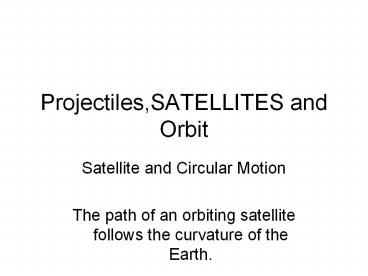Projectiles,SATELLITES and Orbit - PowerPoint PPT Presentation
1 / 22
Title:
Projectiles,SATELLITES and Orbit
Description:
Projectiles,SATELLITES and Orbit Satellite and Circular Motion The path of an orbiting satellite follows the curvature of the Earth. Projectile Defined Any launched ... – PowerPoint PPT presentation
Number of Views:67
Avg rating:3.0/5.0
Title: Projectiles,SATELLITES and Orbit
1
Projectiles,SATELLITES and Orbit
- Satellite and Circular Motion
- The path of an orbiting satellite follows the
curvature of the Earth.
2
Projectile Defined
- Any launched object that moves through air or
space under the influence of gravity.
3
Horizontal Motion Associated with a Projectile
- Objects launched horizontally continue in a
horizontal direction a constant speed due to its
inertia.
4
Vertical Motion Associated with a Projectile
- Objects motion is accelerated due to the force
of gravity (free falling!!)
5
Projectile Motion Review
6
How would you describe the downward motion of the
two balls?
7
What is an Earth Satellite?
- A projectile that circles the Earth due to
gravitational force. - Orbit occurs because the object moves fast enough
to fall continuously towards the Earth and miss
it.
8
Horizontal vs. Vertical Motion for Satellites
tangential velocity (or rotational velocity)
gravity
Note the curved projectile path!
There is a balance between the tangential speed
of the projectile and the force of gravity acting
on the projectile
9
Projectile Path Principles
- The greater the objects horizontal motion (or
speed), the wider the arc of its curved path. - If thrown from the same height, both projectiles
will land at the same time even if their
horizontal speeds are different.
See Figures 14.1 and 14.3 on page 263.
10
Figure 4
b
a
1) Label the arrows as gravity or sideways
velocity. Place term inside box.
- Which arrow represents centripetal force?
- 3) What would happen to the moon if the Earths
gravity suddenly disappeared?
11
Horizontal vs. Vertical Motion
Orbital velocity
gravity
There is a balance between the orbital velocity
of the projectile and the force of gravity
pulling on the projectile (as the projectile
pulls on the Earth)
12
The Earth Curves
A horizontal speed of 8 km/s will cause the
projectile to become a satellite.
13
Circular Orbits
- A projectile with a speed of 8 km/s will orbit
the Earth in a circle.
A satellite in circular orbit is always moving
perpendicular to gravity.
14
Satellites Path
- The shape of the path of a satellite is circular
or elliptical (oval).
An ellipse is a closed oval-shaped path. The
Earth orbits the Sun in an ellipse!
15
Circular and Elliptical Orbits
- The cause for a projectile to orbit the Earth is
the horizontal speed of the projectile. - Checking horizontal speed (tangential velocity)
- -Less than 8 km/s no orbit
- -At 8 km/s circular orbit develops
- -Greater than 8 km/s elliptical
- orbit develops
16
Orbit
- A successful orbit occurs when the horizontal
speed balances the downward acceleration of
gravity. - The unbalanced force caused by gravity provides
the change in velocity needed to keep the
satellite turning. - Checking horizontal speed (tangential velocity)
- -Less than 8 km/s no orbit
- -At 8 km/s circular orbit develops
- -Greater than 8 km/s elliptical
- orbit develops
- -escape velocity at 11.2 km/s
17
Escape Speed
- A vertical speed that is sufficient to ensure
that the object will leave the Earth or whatever
object from which the projectile is launched.
18
CENTRIPETAL FORCE
- The force that keeps an object going in a circle
(means toward center). - Gravity, friction and pulling on a cord are
examples of centripetal force. - You feel a push away from the center because of
your inertia. - It takes a force to change your
- momentum.
19
Centripetal Motion Applications
- http//www.glenbrook.k12.il.us/gbssci/phys/mmedia/
circmot/cf.html - http//www.glenbrook.k12.il.us/gbssci/phys/mmedia/
vectors/sat.html - http//sol.sci.uop.edu/jfalward/physics17/chapter
4/chapter4.html
20
References
- http//www-istp.gsfc.nasa.gov/stargaze/Skeplaws.ht
m
21
The Speed of Projectiles and Satellites
- For projectiles and satellites, the speed of the
object is related to differences in the two
components of motion.
22
References
- http//www-istp.gsfc.nasa.gov/stargaze/Skeplaws.ht
m































